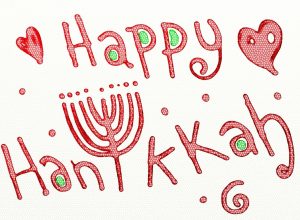 For those who celebrate, the eight-day Jewish Festival of Lights is currently under way, running this year from sundown on December 22nd through December 30th. The Hebrew word Hanukkah (or Chanukah) means “dedication,” and the holiday commemorates the re-dedication of the Holy Temple in Jerusalem after the Maccabean Revolt in 164 BCE. Like most holidays, Hanukkah is celebrated with a variety of traditions, from lighting candles to eating fried foods, but even for those who celebrate, the history of these traditions can sometimes get lost over time. So today, I thought I’d take a moment to examine the significance of some of the most common Hanukkah traditions.
For those who celebrate, the eight-day Jewish Festival of Lights is currently under way, running this year from sundown on December 22nd through December 30th. The Hebrew word Hanukkah (or Chanukah) means “dedication,” and the holiday commemorates the re-dedication of the Holy Temple in Jerusalem after the Maccabean Revolt in 164 BCE. Like most holidays, Hanukkah is celebrated with a variety of traditions, from lighting candles to eating fried foods, but even for those who celebrate, the history of these traditions can sometimes get lost over time. So today, I thought I’d take a moment to examine the significance of some of the most common Hanukkah traditions.
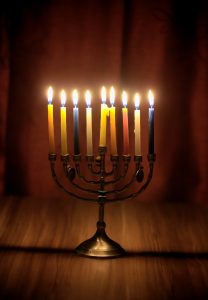 The Menorah or Hanukkiah: Although the word “menorah” is often used interchangeably with hanukkiah, they are not exactly the same. A menorah is a candelabra with seven branches used in synagogues year-round, whereas a hanukkiah is a nine-branched candelabra used specifically on Hanukkah. Lighting the hanukkiah is probably the most important tradition of the holiday. The significance is as follows: After the Jews reclaimed the Holy Temple from the Syrian-Greeks, they wanted to light the menorah in the temple. At that time, menorahs were lit with special ritually-pure olive oil, which took more than a week to prepare. Although they were only able to find enough oil to last for one night, miraculously, the oil burned for eight continuous days, giving them enough time for new oil to be prepared. Today, Jews light the hanukkiah for eight nights to commemorate this miracle. Special blessings are recited before the menorah is lit, and traditional songs are often sung afterward.
The Menorah or Hanukkiah: Although the word “menorah” is often used interchangeably with hanukkiah, they are not exactly the same. A menorah is a candelabra with seven branches used in synagogues year-round, whereas a hanukkiah is a nine-branched candelabra used specifically on Hanukkah. Lighting the hanukkiah is probably the most important tradition of the holiday. The significance is as follows: After the Jews reclaimed the Holy Temple from the Syrian-Greeks, they wanted to light the menorah in the temple. At that time, menorahs were lit with special ritually-pure olive oil, which took more than a week to prepare. Although they were only able to find enough oil to last for one night, miraculously, the oil burned for eight continuous days, giving them enough time for new oil to be prepared. Today, Jews light the hanukkiah for eight nights to commemorate this miracle. Special blessings are recited before the menorah is lit, and traditional songs are often sung afterward.
- Fried Foods: Another way Jews commemorate the miracle of the oil is by eating fried foods. The most common are latkes (fried potato pancakes), but jelly donuts (known in Hebrew as sufganiyot) are also common.
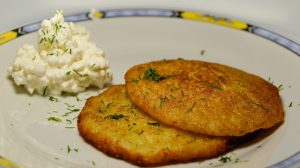
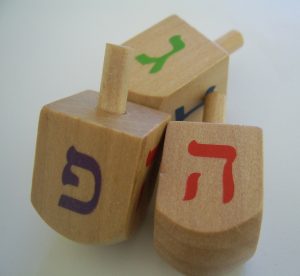 Dreidel Game: A dreidel is a spinning top with a different Hebrew letter printed on each of its four sides. The letters stand for the phrase nes gadol haya sham—”a great miracle happened there.” (Or in Israel, “a great miracle happened here.”). The significance of the dreidel game is somewhat unclear. One story is that before the Maccabees re-dedicated the Temple, Jews were forbidden from practicing their religion–however they continued to do so in secret. Legend has it that when patrols would come by, they would quickly hide their religious texts and pull out the little tops, pretending to be playing with them. Another possibility is that the amusement derived from a similar 16th century game played in Ireland that made its way to Germany. According to Rabbi David Golinkin, President Emeritus of the Schechter Institute of Jewish Studies, “By 1720, the game was called T- totum or teetotum, and by 1801 the four letters already represented four words in English: T = Take all; H = Half; P = Put down; and N = Nothing.”
Dreidel Game: A dreidel is a spinning top with a different Hebrew letter printed on each of its four sides. The letters stand for the phrase nes gadol haya sham—”a great miracle happened there.” (Or in Israel, “a great miracle happened here.”). The significance of the dreidel game is somewhat unclear. One story is that before the Maccabees re-dedicated the Temple, Jews were forbidden from practicing their religion–however they continued to do so in secret. Legend has it that when patrols would come by, they would quickly hide their religious texts and pull out the little tops, pretending to be playing with them. Another possibility is that the amusement derived from a similar 16th century game played in Ireland that made its way to Germany. According to Rabbi David Golinkin, President Emeritus of the Schechter Institute of Jewish Studies, “By 1720, the game was called T- totum or teetotum, and by 1801 the four letters already represented four words in English: T = Take all; H = Half; P = Put down; and N = Nothing.”
- Chocolate Gelt: These foil-wrapped chocolate coins are often used as gambling chips when playing dreidel, however the significance of the coins may have evolved from a few different traditions. One theory is that following the re-dedication of the Temple, Jews used original “gelt” (gold) as a way to reward children for Torah study. Another possible explanation is that coins used to be minted for special occasions and were used as an end-of-the-year tip for itinerant workers. As customs changed, people shifted from giving real money as tips to giving chocolate money as gifts to their children. Also, at one time, Jewish mothers would give their children a small coin on each day of Hanukkah that they could use to buy sugar powder and red coloring that they’d make into a kid-friendly “Hanukkah wine.”
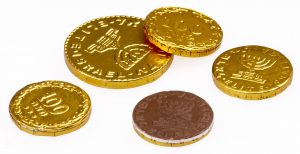
- Gift Giving: To be honest, gift giving (apart from small things like chocolate gelt given to children) is not a traditional part of the Hanukkah celebration. However, as giving gifts started to become a Christmas tradition in the 19th century, and since Hanukkah generally falls at the same time of year, Jews began to incorporate the exchanging of gifts in their celebration of Hanukkah as well.

Thanks for reading! Regardless of what you celebrate, I wish everyone a joyous holiday season and all the best in the new year.
Until next time!
_______________________________________________________________________________________
Sources: The Most Important Hanukkah Traditions, myjewishlearning.com; 5 Hanukkah Traditions Explained, Bustle.com; The Surprising Origins of 5 Hanukkah Traditions, Time.com; What is Hanukkah, Chabad.org

14 comments
1 pings
Skip to comment form
Happy Hanukkah!
Author
Thank you, Denise! 🙂
Chag Hanukkah Sameach!
Author
Thank you, Mirta! Happy holidays to you as well!
Jennifer this was a great post. Except of the candles I didn’t know any other of the traditions I read here and they’re so interesting!
My only problem is that I can’t taste these latkes (I love everything with potato!) and I find myself drooling with the mere idea. (In Greece we have something called “potato balls” which might be similar.)
Now you made me wonder… we have close by a Jewish restaurant. Would they have latkes and sufganiyot? Would they welcome a non-Jew or would I be imposing?
Anyway, I wish you, all, Happy Holidays!
Have fun!
Author
Thank you so much, Alexandra! OMG, latkes are sooooo good. I would definitely give the restaurant a try! I’d think they would have latkes during the holiday, and I can’t imagine that you wouldn’t be welcome. Why don’t you call them and just say that you’ve been dying to try latkes and ask if they make them? But also, they’re fairly easy to make at home. I can send you a recipe if you want. Just let me know! And if you do try the restaurant, I’d love to hear about it. I hope you and your family are having a wonderful holiday season. 🙂
Thank you for sharing this post. Happy Hanukkah!!
Author
Thanks for reading, Jeanne! I hope you and your family are enjoying a wonderful holiday season!
Happy Hanukkah!
Author
Thank you! Happy holidays to you as well! 🙂
I’d definitely like that recipe!
(I’ll let you know about the restaurant. 😉 )
Thank you for the wishes. 🙂
I wish you and your loved ones all the best.
Of course I posted that using the wrong “Reply” button. Hmm…
Interesting to review other religion’s holidays here even if it is over and done with for a year. Thanks for sharing.
Thank you for sharing! Happy Hanukkah! My friend is in a Dementia unit and I can only talk to her on the phone. I asked her to sing the Dreidel song and she remember it! That warms my heart.
[…] bit more about the Jewish Festival of Lights, you can read a brief description of the holiday here. And if you scroll down to the bottom of the post, I’ll be sharing a recipe for potato […]